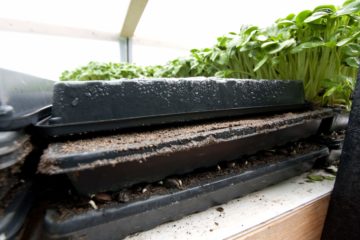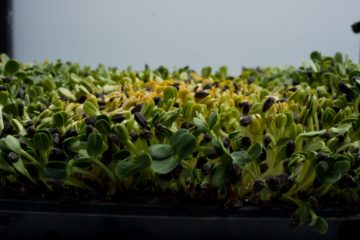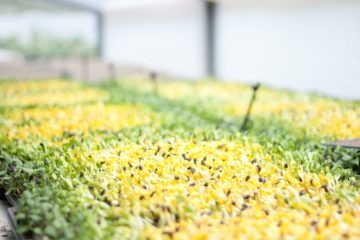You’ve probably seen plenty of claims about how much money you can make growing microgreens. Yet one of the most common questions people still ask is: “Are microgreens profitable”?
The short answer to this question is: Maybe.
And the long answer is complex and somewhat boring.
So, to keep things simple, here are the top 15 things you need to keep in mind if you are starting a microgreens business and want to be profitable:
- Get educated
- It’s not just about the microgreens
- It can be monotonous
- Create a team
- Make a business plan
- Understand your operational costs
- Understand your overhead costs
- Price your products to ensure repeat sales
- Get to know your markets
- Market, market, market!
- Understand and utilize microgreens crop planning principles
- Use appropriate software tools
- Setting hours of work
- Be prepared to expand your business
- Finding the right scale
1. Get educated
If you want to start a business, you better know something about the business you want to start. But for some reason, after growing a few trays of pea shoots on a kitchen shelf, many people think they are ready to make a business of growing microgreens.
Growing microgreens for yourself is one thing; growing microgreens to sell to the public is another – and there are a lot of things you need to consider. So you need to get educated to make sure you can run your business properly. Three key areas for training are:
- How to grow and manage microgreens at a larger scale
- Food safety training
- Local business licensing and zoning bylaws that may apply to you
These are three areas where you need to have a good amount of knowledge for running a microgreens business. You cannot be profitable in a business if you do not understand the business – and every business has its idiosyncrasies you will need to learn.
On learning how to grow microgreens there are four general approaches – and you should use ALL of them:
- Practice growing them yourself
- Search online for free content
- Search online for paid content
- Join online microgreens forums for troubleshooting
There is a good amount of free content on the internet, but when you pay for content you often get the extra gems of information that make all the difference, and they can pay for themselves quickly. But be careful, selling online microgreens courses is a business as well – so don’t be taken in by courses that focus on big numbers but are short on details. Try to find a course with a grower that has proven experience and more than just two or three years of running a business from their garage. We encourage you to shop around, but here are Urban Micro’s courses, offered by SeedLeaf’s Chris Thoreau.
For food safety training you can find lots of great courses online such as the FoodSafe courses common here in British Columbia. Be sure to do a course that is recognized locally and gives you a certificate of completion.
As a food business owner, you have a high level of responsibility to your customers. Cutting corners or not following production protocols can result in customers getting sick. One way to disrupt profitability is with a product recall due to pathogen contamination.
For local business licensing and zoning bylaws you can start online but may need to head down to your local municipal hall to find out the information you need. In many municipalities you may find that microgreens are still unheard of and digging will ultimately get you a firm “No!” So be strategic. Pioneering a business model can be a pain in the ass when dealing with local authorities!
SeedLeaf creates weekly crop sowing projections based on your expected orders and individual crop yields to help you sow the right amount each week.
Try SeedLeaf Now!
2. It’s not just about the microgreens
Don’t get so focused on growing microgreens that you forget about all the other aspects of the business that will take up just as much of your time. This includes:
- Bookkeeping
- Stock management
- Deliveries
- Marketing
- Collecting overdue invoices
- Website maintenance
- Knife sharpening
- Sweeping and mopping
- Developing standard operating procedures
- Just to name a few…
You will spend more time doing all these activities than actually growing microgreens. And if you do even ONE of them poorly, then your ability to be profitable will be compromised.
3. It can be monotonous
If you like doing the same things over and over and over and over (and over) again every single week, then a microgreens business is for you!
Filling trays with soil, sowing trays, washing trays, picking hulls off of sunflower shoots – this is your life now. It damn well better be profitable if this is how you’re now spending your time!
That said, invest in some good headphones and pick your favourite podcasts and head off to work…
4. Create a team
You will notice there is a lot of focus on running a microgreens business as an individual, but you will certainly have more success if you have a team. This is one way of addressing the three points above, since all of these things can become much easier with a team. Obviously working with others can bring challenges, but so can doing everything yourself.
Get over this idea that you can do everything on your own. It is a myth. With a team you can complement each others’ skills and split up the tedious tasks so they are not all up to you.
SeedLeaf helps you manage your orders with ease through client management options like standing orders, product types, and customer categories.
Try SeedLeaf Now!
5. Make a business plan
The value in making a business plan is not just having it in place, but rather having put it together at all. It is through the process of developing and refining your business plan that you will learn a lot about how to run (and not run) your business.
Developing a business plan can be a good team building exercise in itself, and is the process in which you can figure out how profitable your business can be. So, if you want to know: “Are microgreens profitable?” you will need to develop a business plan to find out.
6. Understand your operational costs
Some of the investments required when developing your microgreens business are obvious. You have some key infrastructure components like:
- Shelves
- Lights
- Trays
And your key crop production and packaging inputs such as:
- Seeds
- Soil
- Clamshell packaging
But it can be the little things that push your actual finances above what you had anticipated. Stuff that might get overlooked include:
- Paper towels (and a dispenser) for hand washing
- The Food Pedalers used to spend up to $500 a year on paper towels alone!
- Cleaning supplies
- Storage totes
- Farmers Market Setup
These seemingly smaller items can add up very quickly and add a significant amount to your costs.
And of course, if you have staff you have your labour costs to consider. These include income taxes, employment insurance, workers compensation, and any benefits you may offer – plus a program to manage your payroll.
Check out this general equipment start up list here from Urban Micro to get a sense of where things can add up.
7. Understand your overhead costs
You need to consider your overhead costs, which are generally the same whether you are producing 20 or 200 trays a week. Overhead costs are often overlooked when planning a microgreens business. These include things like:
- Web hosting
- Insurance
- Space rental
- Electricity
- Organic certification
Overhead costs are often neglected when folks talk about microgreens finances.
Why is understanding your costs so important? There are four key reasons:
- If you budget based on those projections and go way over budget, you could find yourself out of business before you even get started
- If you are borrowing money to get started, you need to know how much to borrow
- Without reasonable financial projections, it is hard to know whether you are on track to be profitable
- They help you understand the scale at which you need to operate to be profitable
Do not spend all your time focusing on how much revenue you can generate and neglect the corresponding expenses.
SeedLeaf comes preloaded with an editable database of 43 crops which includes individual crop sowing rates, expected yields, and growth days.
Try SeedLeaf Now!
8. Price your products to ensure repeat sales
This is a very important fact to consider in the longevity of profitability of your business. While you need to price your products to be profitable, you also need to price them to ensure repeat sales. Getting your first sales may be easy, but is your pricing good enough to keep your customers coming back?
It will likely not take you long to notice that microgreens businesses come and go pretty quickly. One reason is that they cannot maintain repeat sales. You need to be profitable, but so do your business customers, so your pricing will determine how long they carry your products for.
Pricing is also related to scale. As you scale up your business you will go through different phases of profitability. You may find at 20 trays a week you cannot make money, but at 100 trays a week you can. This is for a few reasons:
- Your overhead costs are reduced on a “per-tray” basis
- Your systems, hopefully, become more efficient as you scale up. In fact, they must become more efficient. As you scale up, you’ll need to be more efficient to make the work tolerable!
- Adding additional work adds proportionally less labour
- Growing from 100 trays per week to 110 trays per week will change your variable costs (e.g., seeds, soil cost will increase by about 10%), but your labour will not likely increase at the same rate. One key reason for this is because most activities have a set up and break down time, which, like your overhead costs, are reduced on a per-tray basis as you scale up.
9. Get to know your markets
You have many options for selling your microgreens, such as:
- Farmers markets
- Restaurants
- Grocers
- Subscription programs/home delivery
- Wholesalers
Each of these potential markets has its pros and cons, so you need to determine which will work best for you. Here are some things to consider with each:
| Customer Type |
Pros |
Cons |
| Farmers Markets |
|
|
| Subscription programs |
|
|
| Restaurants |
|
|
| Grocers |
|
|
| Wholesalers |
|
|
A resilient model, especially as you grow, will often incorporate all of these customers. We have listed them above in order of preference in terms of where you should start, but this will vary depending on your region.
10. Market, market, market!
In short, you need to be marketing all the time. This helps ensure your sales can grow – or even stay steady. Sales can fluctuate as customers come and go, so constant marketing can keep a steady flow of new customers coming in.
Marketing can be tricky and disheartening, because sometimes the pay off does not occur for many months after your first contact – so be patient! Check out our blog post on marketing strategies here and check online for all sorts of free marketing ideas and tools.
11. Understand and utilize microgreens crop planning principles
Of course we here at SeedLeaf think crop planning is important!
Crop planning is the art of calculating and organizing your crop needs based on your confirmed, expected, and target orders. This can be done with a simple spreadsheet, an advanced spreadsheet, or with SeedLeaf.
Here are a few reasons why proper crop planning is important for profitability:
- Ensures you have enough crop to meet your order needs. Nothing is worse than losing a sale due to being short on product
- Reduces waste as you are not growing excess amounts of crop
- Keeps you organized and reduces administrative time
- Helps with record keeping and accountability
SeedLeaf reports break down your sales by customer, products, and size to give you a comprehensive look at your financials.
Try SeedLeaf Now!
12. Using software tools
There are multiple software tools you can use to help run your business. In most cases, these tools will pay for themselves almost instantly, so utilize the ones that make sense to you. One of the key things to understand is WHEN to adopt these tools. In short, when tasks seem to become tedious because they are taking too long or are difficult to manage, this is a sign you need some support. If you have five customers, then using simple manual systems may be fine. But if you have 50 customers, you will likely need more technology support.
There are both free and paid options for most programs, so evolve as you need to, utilizing free options as long as possible. But as soon as you start trying to hack the program to maintain the free option, chances are you need to shift to the paid option. While paid technology may seem like an added expense, it is best to think of it as an investment which frees up your time, improves your productivity, and improves your record keeping.
Here are some suggestions for some areas where software tools are most helpful (other than crop planning of course!):
- Subscription management: If you are offering a subscription program then a subscription management program can help keep customers and orders organized.
- Invoicing: There are now lots of invoicing programs available which allow customers to sign for receipt on your phone. The amount of time a good invoicing program can save is incredible.
- Bookkeeping: Find a program that links to your bank account allowing you to quickly categorize your revenue and expenses. Many free options are available.
- Google Analytics: To help you understand how effective your outreach and marketing are.
- Record keeping: Google Forms is a great option for logging tasks such as cleaning activities and seed sanitizing.
13. Setting hours of work
Having set hours of work can help you stay structured and ensure work does not creep into your personal life. In the early days of your business it will certainly be work, work, work all the time, but as you get more established you can benefit from setting a regular work routine. This can help you be more productive during your work time and reduce the amount of hours you work to be profitable. If you work too many hours, your profitability per hour of work will be reduced.
14. Be prepared to expand your business
Ironically, many growers do not plan their microgreens business for success. In other words, they are not prepared to expand their production space if they have increased demand. This often happens with home production systems. The inability to expand can have multiple effects on profitability:
- Your goal is to both maximize (get to close-to-peak capacity) and optimize (run efficiently) your production space. If you start to outgrow that space your efficiency will decline as you try to fit more crop into your space than it can handle.
- Being unable to fulfill orders means potential customers are likely to go to a competitor for microgreens and it can be hard to get those customers to change suppliers.
- You will spend more time managing aspects of your production that do not lead to increased sales.
PRO TIP: One way to expand within a given space is to shift from one harvest a week to two harvests a week and stagger your crops and delivery days. This only works with short-cycle crops (7 to 9 days).
15. Finding the right scale
When you put all the things above together, what it often comes down to is finding the right scale for your operation. What scale you settle on will depend on:
- How much space you have available to start and grow your business
- Your ability/willingness to bring in support staff or create a team
- How much time you have to put into your business
- How much of a local market you have
While these principles are focused on smaller-scale businesses, they also apply if you want to build a microgreens empire.
Designed for microgreens growers at all scales, SeedLeaf will help streamline your operation in ways you didn’t even know were possible.
Try SeedLeaf Now!
So, are microgreens profitable?
As is often the case, whether or not microgreens are profitable really depends on multiple factors. But whether or not YOU will be successful in starting a microgreens business depends on how well informed you are on the financial aspects of YOUR business model. And take everything you read on the internet about the profitability of microgreens with a grain of salt.



0 Comments